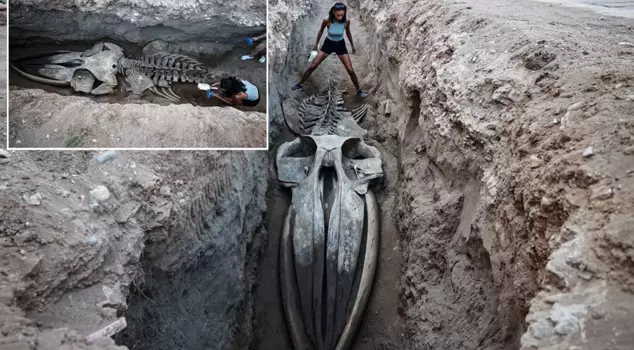
07.10.2025 10:50
The process of excavating the 14-meter-long fin whale skeleton, which was buried after washing ashore in Mersin in 2021, is ongoing for scientific studies. As part of the project "The Whale's Silence is Turning into Science," the excavation work in the soil where it was buried aims to assemble the whale skeleton, most of which has become visible.
The excavation works within the scope of the project "The Silence of the Whale is Turning into Science," aimed at bringing the skeleton of the Fin whale buried in the garden of the Yenişehir Campus by the university 4 years ago into scientific studies, are ongoing.
Governor Atilla Toros visited the excavation site of the project led by Prof. Dr. Deniz Ayas, a faculty member of the Mersin University (MEÜ) Faculty of Fisheries Processing Technology.
After receiving information about the works, Toros accompanied the process of extracting the whale skeleton, most of which has become visible.
MEÜ Rector Prof. Dr. Erol Yaşar also participated in the event where Toros cleaned the soil off the skeleton with a brush.
"IT WILL BE EXHIBITED IN THE MARINE LIFE MUSEUM"
Governor Toros stated to the journalists that an important scientific activity is being carried out for Mersin.
Congratulating the team that buried the Fin whale that washed ashore in 2021 at the MEÜ Yenişehir Campus, predicting four years ahead, Toros said, "The scientific activity we are currently excavating is also being conducted alongside an important educational activity. It has been a significant excavation carried out with our students. We know that nearly 400 students have registered to participate in this activity."
"IT WILL MAKE A SIGNIFICANT CONTRIBUTION TO OUR CITY"
Toros stated that the skeleton will be exhibited in the MEÜ Marine Life Museum and said:
"Mersin is an important city in terms of history and cultural heritage. It is also a city with significant biodiversity, from its seas to its mountains, and from its coasts to its forests. In this sense, we are conducting important work to protect biodiversity and cultural heritage and to pass it on to future generations. The extraction of the skeleton, including the jawbone, skull, chest, and tail vertebrae, is an important work in terms of both academic studies and exhibition. We believe it will be a surprising and scientifically significant contribution, and we think it will be an important addition to our city."
MEÜ Rector Prof. Dr. Erol Yaşar expressed their happiness and honor in carrying out this event at their university, where students' scientific curiosity and sense of exploration are met.
THE ENTIRE SKELETON WILL BE UNEARTHED WITHIN TWO DAYS
Prof. Dr. Ayas, who is leading the project, noted that they have completed the 4th day of the excavation works, stating, "We have currently unearthed the head, neck vertebrae, and the entire chest area from underground. The lumbar and tail vertebrae section remains. We plan to extract the entire skeleton in the garden of our museum within two days."